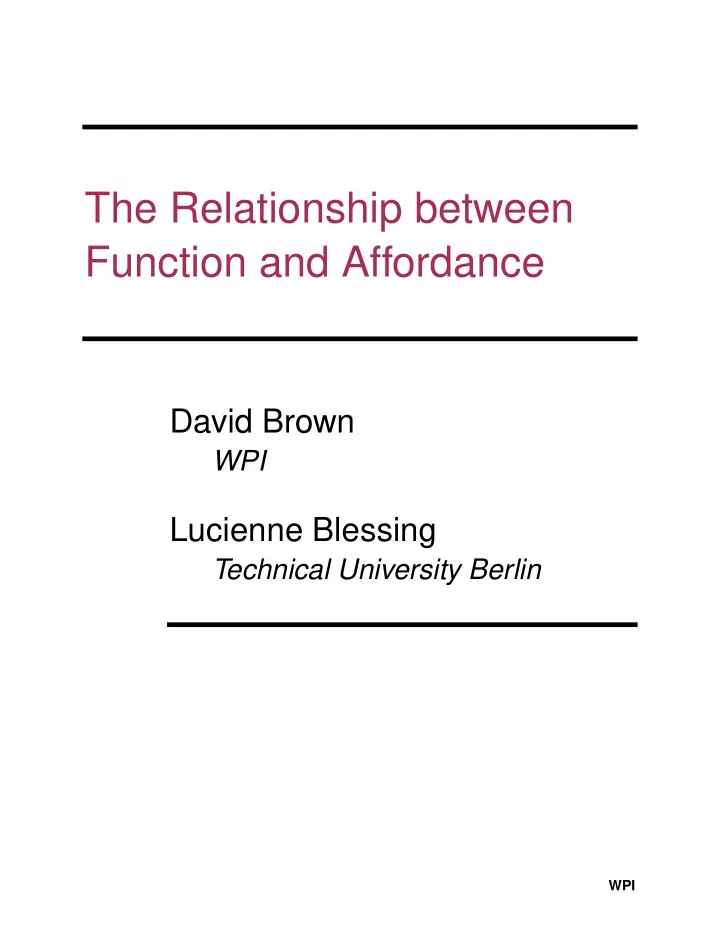

The Relationship between Function and Affordance David Brown WPI Lucienne Blessing Technical University Berlin WPI
Objectives ❒ present a model of function ❒ clarify the concept of affordances ❒ relate affordances to function ❒ discuss reasoning with affordances WPI
Not an Objective ❒ To attack existing work on Affordances. However, we feel that evaluation, critiquing and discussion are valuable. WPI
Sources & Influences Chandrasekaran & Josephson (2000) Function in Device Representation Maier & Fadel (2003) Affordance-Based Methods for Design Rosenman & Gero (1998) Purpose and function in design: from the socio-cultural to the techno-physical Norman (1988) The Psychology of Everyday Things Hartson (2003) Cognitive, physical, sensory, and functional affordances in interaction design WPI
Motivation ❒ use of functions and functional decomposition in design is common ❒ Maier and Fadel (M&F) proposed an alternative approach to designing that uses affordances ❒ There’s a lot of ambiguity in the terms “function” and “affordance” WPI
A Model of Function Place D in an Environment. World: W Environment: E Device: D WPI
Mode of Deployment M(D, E i ) for all R i at time t. E R 1 R m D WPI
Behaviors ❒ M(D, E i ) enables interactions between D and E i ❒ Interactions are interpreted as “Behaviors” ❒ Behaviors can be at an instant or over time. ❒ Behavioral Constraints B i are: ➥ Patterns of interactions involving the state of D and the state of E WPI
Roles and Function If a role is desired by an agent/entity then the set of B i provides a function for D in E E Desired Role 1 Role 2 B i B i D WPI
Desired Agent ... ... Goal Intention Plan P = {O 1 , O 2 , ...O i ... O n } Conditions Executable C i Operation B j D WPI
Example (D = Pen) Goal: to have another human know the information that you desire to tell them. Intention: get paper, get pen, write message, transfer paper to other human. Plan: grip pen, orient pen, put pen tip to paper, apply pressure, move pen. B: ink flows from tip; ink coats the paper; the tip is moving. Mode of Deployment: human grips pen; pen tip is down; tip in contact with paper; tip exerts pressure on the paper. Device-centric function: to cause ink to flow out of its ink container onto the tip. Environment-centric function: to cause a piece of paper to have ink on it. WPI
Affordances Affordances are context-dependent action or manipulation possibilities from the point of view of a particular actor. ➥ The actor is considered to be the entity, human or otherwise, capable of taking action. ❒ The set of affordances of a device is a very large set! ➥ i.e., the set of all potential agent behaviors that the device might allow. ➥ i.e., all the Operations O i , Plans P i , or Intentions I i that the device might allow. ➥ e.g., Cell phones afford throwing. WPI
Affordances For all M(D, E i ): O 2 O 3 O 4 O 1 C 1 C 2 C 3 C 4 ... ... ... ... B 1 B 2 B 3 B 4 D WPI
Reasoning Design Affordances ➥ Hard to do without guidance. ➥ Very useful for design evaluation. Design Function ➥ Usually provided (Intended Function). ➥ Hard to reason out without M(D, E i ). Function Design ➥ Using functional decomposition. ➥ Existing designs may be indexed. Design Affordances ➥ Not normally indexed. ➥ May be able to map to function. WPI
Conclusions ❒ Affordances very useful for design evaluation. ❒ Hard to determine all relevant affordances. ❒ Explicit models of function and affordance useful in the development new techniques and tools. ➥ explicit representations needed to allow explicit reasoning. ➥ e.g., functional basis. ➥ e.g., matching (and therefore analogy) by Goal, Operations, Behavioral Constraints, and Mode of Deployment, in addition to device structure and device behavior. Note: AIEDAM Vol.19, No. 2 & 3, 2005, Special Issue: Engineering Applications of Representations of Function. WPI
Recommend
More recommend